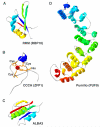The emerging role of RNA-binding proteins in the life cycle of Trypanosoma brucei
- PMID: 24438230
- PMCID: PMC3974610
- DOI: 10.1111/cmi.12268
The emerging role of RNA-binding proteins in the life cycle of Trypanosoma brucei
Abstract
One of the key questions in understanding the biology of an organism is how to correlate cellular fate and function with gene expression patterns. This is particularly relevant for pathogenic organisms, like the parasitic protozoa Trypanosoma brucei, who often cycle between different hosts, thereby encountering vastly different environments. Survival in and adaptation to new surroundings requires activation of specific gene networks, which is most often achieved by regulatory mechanisms embedded in the transcriptional machinery. However, in T. brucei and related trypanosomatids these responses appear to be accomplished mainly by post-transcriptional mechanisms. Although an understanding of how this parasite modulates gene regulatory networks is in the early stages, RNA-binding proteins (RBPs) are beginning to take centre stage. Here, we discuss recent progress in the identification of RBPs with crucial roles in different stages of the T. brucei life cycle, and in elucidating targets of RBPs.
© 2014 John Wiley & Sons Ltd.
Figures


References
-
- Amann BT, Worthington MT, Berg JM. A Cys3His zinc-binding domain from Nup475/tristetraprolin: a novel fold with a disklike structure. Biochemistry. 2003;42:217–221. - PubMed
-
- Benz C, Mulindwa J, Ouna B, Clayton C. The Trypanosoma brucei zinc finger protein ZC3H18 is involved in differentiation. Mol Biochem Parasitol. 2011;177:148–151. - PubMed
-
- Bordoli L, Kiefer F, Arnold K, Benkert P, Battey J, Schwede T. Protein structure homology modeling using SWISS-MODEL workspace. Nat Protoc. 2009;4:1–13. - PubMed
Publication types
MeSH terms
Substances
Grants and funding
LinkOut - more resources
Full Text Sources
Other Literature Sources

